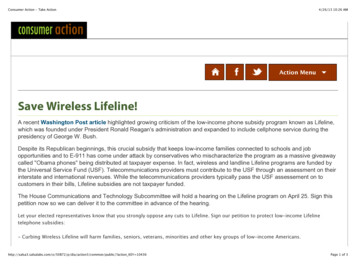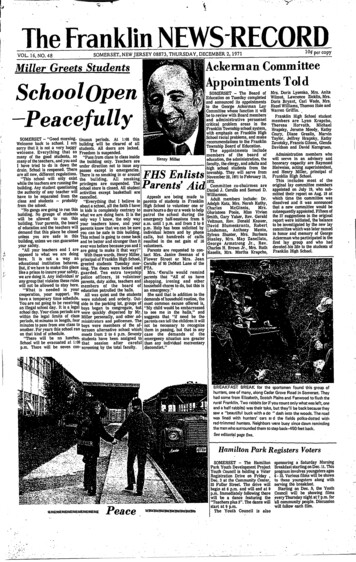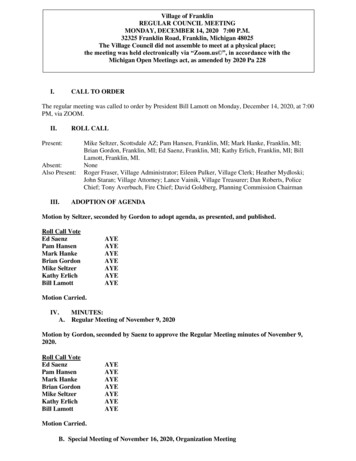
Transcription
FRANKLIN COUNTYOPIATE ACTION PLANBuilding the Bridge to TomorrowFranklinDepartment of Sanitary EngineeringFRANKLIN COUNTY OPIATE ACTION PLANI Building the Bridge to Tomorrow1
Building the Bridge to TomorrowTable of ContentsLetter from Franklin CountyCommissioners President John O’Grady .2Letter from Columbus Mayor Andrew J. Ginther .3Letter from Columbus City Council President Zach Klein .4Acknowledgments .5Introduction . 6-9Plan Development and Committee Structure . 10-15Section 1 Prevention and Community Education . 16-20Prevent Opiate* Abuse and AddictionSection 2 Healthcare and Risk Reduction . 21-26Reduce the Number of Opiate-Related DeathsSection 3 Treatment and Supports . 27-32Expand Access and Decrease Wait For TreatmentSection 4 First Responders and Law Enforcement.33-37Improve the Safety of Our Community*We recognize there are some nuances between the terms opiate and opioid. For the purposes of this report,the term opiate will refer to both natural and synthetic drugs derived from opium.FRANKLIN COUNTYPLANthetheBridgeto I BuildingBridgeto TomorrowI Building11
Building the Bridge to TomorrowLetter from Franklin CountyCommissioners PresidentJohn O’GradyDear Community Member,It is the charge and duty of the Franklin County Board ofCommissioners to ensure the future is bright for every FranklinCounty resident. When we saw, last year alone, 353 of ourresidents died of accidental overdoses, we knew reversing thetide of the opiate epidemic would require a heightened andaggressive community response. We are facing a true publichealth crisis that is claiming the lives of our brothers, sisters,aunts, uncles, friends, neighbors and co-workers.Our priority must be to tackle the opiate epidemic and savemore lives, and this report is a reflection of the work yet to come.It encompasses many diverse partners including elected officials,public health officials, medical personnel, first responders,law enforcement, mental health clinicians, consumers, familymembers and faith community members to name a few.In this report, you will see the outline of four pillars – preventionand community education; healthcare and risk reduction;treatment and supports; and first responders and lawenforcement. You will also see both short term and longer termstrategies to address the opiate epidemic and the accountabilitystructure for how this plan will come to life. This approach is alsoimportant because it provides a framework our community canadopt for any future community emergencies.The Franklin County Board of Commissioners is proud to supportthe implementation of this plan by providing both personneland financial support. But most importantly, we are proud ofwhat this plan represents. Together, we will save lives.Sincerely,John O’Grady, PresidentFranklin County Board of CommissionersFRANKLIN COUNTY OPIATE ACTION PLANI Building the Bridge to Tomorrow2
Building the Bridge to TomorrowLetter from Columbus MayorAndrew J. GintherDear Neighbor,The City of Columbus has been ranked one of the best places inthe world to live. But we are not immune to the epidemic that ishappening in cities all over the country. Addiction has becomea public health crisis in our community and affects every school,every church, and every business in the city and Franklin County.We have held numerous community conversations about thiscrisis. The talk is important – every time we discuss addictionand the effect it has on our families, friends and colleagues, wechip away at the stigma that surrounds the disease. But it is nowtime to act.The City of Columbus is joining with Franklin County, public healthand social services agencies, first responders, law enforcement,healthcare organizations and businesses to address this crisiswith an action plan in four key areas: prevention and communityeducation; healthcare and risk reduction; treatment and supports;and first responders and law enforcement.I want to thank all of the elected officials, organizations andindividuals who worked together to develop this action plan thatwill save lives. This collaborative effort gives us an opportunity tobuild a response structure that empowers us all to work in betterand smarter ways to address the opiate crisis that threatensour community.Assistant Fire Chief Jim Davis says that every time we save a life,we have the chance to be someone’s bridge to recovery – theirbridge to the future. Together, we will lift up those struggling withsubstance use disorders and their families and friends byworking together.Sincerely,Andrew J. Ginther, MayorCity of ColumbusFRANKLIN COUNTY OPIATE ACTION PLANI Building the Bridge to Tomorrow3
Building the Bridge to TomorrowLetter from Columbus CityCouncil President Zach KleinDear Community Member,Members of Columbus City Council are committed to ensuringthe safety of everyone working, living, and raising a family in theCity. Columbus is growing. We are now the 14th largest city inthe country. With our growing population and economy, ourCity has seen countless opportunities and successes, but likeother metropolitan areas, we also have significant issues andproblems that must be addressed and solved. In the last severalyears, Columbus, like the rest of Ohio, has seen a drastic increasein drug overdoses from opiate use. Addiction is a mental healthcrisis that not only affects the user, but also family, friends, coworkers, neighbors, and our economy. Families are torn apart andcommunities are suffering as a result of the opiate crisis.City Council has allocated additional funds for treatment facilities, special docket courts, and needleexchange programs. We have supported the efforts of the Columbus Division of Fire and now theColumbus Division of Police to carry life-saving Narcan. My colleagues and I are proud of these efforts,but we know that more must be done. It is not enough only to save lives; we must also change lives.The City of Columbus and Franklin County are partnering with public health departments, serviceproviders, law enforcement, and the private sector to address this mental health issue. ThisAction Plan developed by ADAMH will focus on implementing solutions in four areas: Preventionand Community Education, Healthcare and Risk Reduction; Treatment and Supports; and FirstResponders and Law Enforcement.I am grateful for David Royer and the ADAMH staff for the vision outlined in this plan. I would alsolike to thank all of the government officials, law enforcement personnel, social service agencies, andcommunity partners that assisted ADAMH with information and input. I am honored to be a partof a community where so many organizations and individuals have come together to work towardssolutions for this devastating epidemic.In closing, it is important to note that addiction and its negative impact on a community are notnew. In fact, drugs have ravaged many communities, particularly minority communities, withoutthe same attention and concern that it should have received. We cannot correct the historicalwrongs, but we can build a sustainable and effective model to address mental health issues, likedrug addiction, for the future, regardless of the popular drug of the day or whom it is affecting.It is time to join hands, like we always do, to execute the actions items outlined in this plan, andColumbus City Council is ready to do it.Sincerely,Zach Klein, Council PresidentCity of ColumbusFRANKLIN COUNTY OPIATE ACTION PLANI Building the Bridge to Tomorrow4
Building the Bridge to TomorrowAcknowledgmentsSpecial thanks to all the organizations and community members whoprovided insight and expertise to make this action plan a reality.Abraxas Counseling CenterAdvanced Recovery ServicesAetnaAlvisByron L. Potts & Co., LPACareSourceCentral Ohio Hospital CouncilCity of Whitehall, Division of PoliceCity of Whitehall, Mayor’s OfficeColumbus Area Integrated Health Services, Inc.Columbus City CouncilColumbus Division of FireColumbus Division of PoliceColumbus Public HealthColumbus Urban LeagueCommunity for New DirectionCommunity Shelter BoardCompDrugConcord CounselingConsumer and Family MembersEquitas HealthEthiopian Tewahedo Social ServicesFamily Missionary Baptist ChurchFranklin County Children ServicesFranklin County Coroner’s OfficeFranklin County Court of Common PleasFranklin County Court of Common Pleas– Adult ProbationFranklin County Municipal CourtFranklin County Public DefenderFranklin County Public HealthFranklin County Sheriff’s OfficeGreater Hilltop Area Shalom ZoneGroveport Madison SchoolsFRANKLIN COUNTY OPIATE ACTION PLANHamilton Township Fire DepartmentHeart of Ohio Health CenterHouse of Hope, Inc.Loud Life FoundationLower Lights Christian Health CenterLower Lights MinistriesMaryhavenMolina HealthcareMount Carmel HealthNationwide Children’s HospitalNetcare AccessObetz Police DepartmentOffice of the Franklin County Prosecuting AttorneyOhio HealthOne Day MomsOne Nine NinetyOptumParamount Health CarePrimaryOne HealthRecovery Works ColumbusSoutheast, Inc.State of Ohio Board of PharmacySynteroTalktainment RadioThe Ohio State University Wexner Medical Center– Department of Psychiatry and Behavioral HealthThe Ohio State University Wexner Medical Center– Talbot HallTwin Valley Behavioral HealthTyler’s LightUnited HealthcareUnited State District Court, Southern District of OhioUnited States Probation, Southern District of OhioI Building the Bridge to Tomorrow5
Building the Bridge to TomorrowIntroductionThe opiate epidemic is eroding the quality of life for Franklin Countyresidents. This public health crisis is killing our residents anddevastating families. It is impacting every sector of our economy,including healthcare, education, business and local governments.The Franklin County Board of Commissioners, the Officeof Columbus Mayor Andrew J. Ginther, and the agenciesthroughout the city and the county that are touched by theopiate crisis have developed an aggressive plan to save asmany lives as possible.The Franklin County Opiate Action Plan assertively attemptsto stabilize the issue in the short term while offeringimportant long-term strategies. The plan focuses on fouroverarching goals:1. Prevent opiate abuse and addiction;2. Reduce the number of opiate-related deaths;3. Expand access and decrease wait for treatment; and4. Improve the safety of our community.This plan is intended to be dynamic. As the opiate epidemicevolves, the actions identified in this plan will change asneeded. In order for this plan to be fully implemented, it willrequire additional resources at many levels.It is important to note that this plan does not directly addresshow to reduce the supply of opiates in our community.Our law enforcement partners are addressing this directly.While this is a critical goal, these ongoing efforts through lawenforcement activities fall outside the scope of this plan.FRANKLIN COUNTY OPIATE ACTION PLANI Building the Bridge to TomorrowMeet JanThroughout this plan,you’ll have the opportunityto meet Jan. We’ll shareinformation about herpersonal journey with anopiate-use disorder.6
Building the Bridge to TomorrowHow Did We Get Here?There are many social factors that increase a person’s risk of becoming addicted to asubstance, including but not limited to poverty, homelessness, unemployment and trauma.However, there are three major factors that caused the opiate problem to shift to a crisisthroughout our entire community.These are:1.1 Misuse and Abuse of Prescription Drugs2 Resurgence of Heroin2.a. As prescription pain pills were getting more difficult to get with the crackdownon pill mills and overprescribing, people were turning to heroin which wascheaper and easier to get.3 Introduction of Synthetic Opiates3.a. Examples of synthetic opiates are fentanyl and carfentanil. Although heroinuse and fentanyl are not new phenomena, the scale of the problem hasincreased dramatically, particularly due to the increasing prevalence of fentanylin the U.S. and the Midwest specifically.“As a society we have created and supported this false premise and narrativethat life should be ‘pain free’ both physically and emotionally. Although this isnot true of course, people have found that opiates address both types of pain,thus feeding the epidemic.”– Dr. Mark Hurst, Medical Director, Ohio Department of Mental Health and Addiction ServicesThe opiate epidemic is a national crisis. Each day in the UnitedStates, approximately 129 people die as a result of a drugoverdose. (Drug Enforcement Administration, 2016 NationalDrug Threat Assessment Summary). In addition, the Center forDisease Control (CDC) estimates that for each person who diedfrom a prescription painkiller overdose in 2008, there were 10people admitted for treatment for substance use disorder, 32people visited the emergency department for substance usedisorder, 130 people who were abusers or dependent, and 825non-medical users. (Centers for Disease Control and Prevention,Morbidity and Mortality Weekly Report (MMWR), Increases in Drugand Opioid-Involved Overdose Deaths – United States, 2010-2015).Ohio has been especially hard hit by the epidemic. On average,eight people in Ohio die every day from an overdose (OhioDepartment of Health). For the ninth year in a row, unintentionaldrug overdose remains the leading cause of injury-relateddeaths for Ohioans (Ohio Department of Health). The increasein overdose deaths continues to be driven by the prevalence offentanyl in many parts of the state, with 1,155 people dying in2015 attributed to fentanyl, an increase from 503 people in 2014(Ohio Department of Health).FRANKLIN COUNTY OPIATE ACTION PLANI Building the Bridge to TomorrowFOR EVERY1 DEATHfor10 admittedtreatment32 visited the ERordependent130 abusersusers825 nonmedical7
Building the Bridge to TomorrowIn 2016, 353 people died in Franklin County due to an accidental drug overdose (2016Annual Report, Franklin County Coroner’s Office). Over the past five years, the number ofpeople who died from an accidental drug overdose increased by 71%. (2012-2016 AnnualReport, Franklin County Coroner’s Office). Franklin County reported the ninth most deathsdue to fentanyl in 2015 (40 deaths). This is fewer than Hamilton (1st, 195 deaths) andCuyahoga (5th, 83 deaths) (Ohio Department of Health). The 13 counties with the mostdeaths due to fentanyl account for three quarters (75%) of all fentanyl-related deathsin Ohio in 2015 (Ohio Department of Health). In general, fentanyl-related overdoses arehighest among people ages 25 to 34 (32%) and men (70.5%) (Ohio Department of Health).Prescription MisuseThree out of four people who use heroin report first misusing prescriptionopiates (JAMA 2014, Prescription Drug Abuse, Heroin Use Among Suburbanand Rural Whites).HealthcareThe impact on healthcare costs for prescription drug use disorders is 25 billionannually (Drug Enforcement Administration, 2016 National Drug ThreatAssessment Summary).Hepatitis CThe number of persons infected with Hepatitis C has increased from 950 casesin 2012 to over 1,600 cases in 2015 in Franklin County (Columbus Public Health,Opiate Abuse: A Public Health Crisis).Neonatal Abstinence SyndromeChildren born in central Ohio hospitals who were exposed to drugs in placenta orfrom breast milk increased from 424 in 2012 to 665 in 2015, with preliminary datafor 2016 indicating 744 encounters through September 30, 2016 (2017 FranklinCounty Opiate Crisis Summit Presentation, Dr. Anahi Ortiz).Children Services28% of all children taken into protective custody by children services agencieshad parents who were using opiates at the time of removal from the home, and70% of children in custody under the age of one have opiate-involved parents(Public Children Services Association of Ohio, The Opioid Epidemic’s Impact onChildren Services in Ohio 2017).First RespondersIncidents involving naloxone administration have increased from an averageof 5.18 per day in 2011 to 6.48 in 2016 (Columbus Public Health, NaloxoneTreatment Monthly Breakdown).The average number of doses administered per day has also increased dramaticallyfrom 6.55 in 2011 to 10.29 in 2016, indicating the presence of ever-stronger strainsof opiates (Columbus Public Health, Treatment Monthly Breakdown).Law EnforcementThe number of law enforcement drug seizures of fentanyl increased from 110in 2013 to 3,882 in 2015 (Ohio Department of Health, 2015 Ohio Drug OverdoseData: General Findings).FRANKLIN COUNTY OPIATE ACTION PLANI Building the Bridge to Tomorrow8
Building the Bridge to TomorrowWhat Are We Doing Now?There are already many local efforts underway to address the opiate epidemic,including but not limited to:Franklin County Opiate Task ForceThe Franklin County Opiate Task Force recognizes substance use disorder as a complex,multifactorial health disorder that can be prevented and treated. The task force exists topromote awareness to the problem in Franklin County, to examine preventive measuresand aid in implementation, to provide educational opportunities for professionals toimprove prescribing of opiates, to examine law enforcement measures and promoteinnovative programs, to examine legislation and promote opiate related bills, and lastly, toexamine our recovery community, increase certified recovery homes and promote use ofpeer recovery advocates. (Franklin County Opiate Crisis Task Force website, About Us page).Since the inception of the task force, they have worked to standardized protocols inemergency departments around opiates and overdoses; developed a pocket guide forproviders with current resources for pregnant women with addiction; created the rapidresponse surge notification protocol and brought naloxone trainings to family membersand friends of loved ones with a substance use disorder.Heroin Overdose Prevention and Education (HOPE) Task ForceThe HOPE Task Force combats the heroin epidemic with a multi-pronged approach:enforcement, education and prevention. Established in 2016, the HOPE Task Force wascreated as a restructuring of the Franklin County Drug Task Force. Experienced narcoticsand homicide detectives working on the HOPE Task Force are treating opiate overdosescenes as crime scenes; investigating the source of the supply that caused the overdose.In addition, HOPE Task Force collaborates with treatment providers to refer those withsubstance use disorders to long-term treatment. Detectives armed with the knowledgeand partnership of treatment providers in the Franklin County community choose to helpthose with an opiate use disorder instead of locking them up. (Franklin County Sheriff’sOffice website, HOPE Task Force page).The Alcohol, Drug and Mental Health Board of Franklin County (ADAMH)Locally, ADAMH continues to direct resources to combat the opiate epidemic. The ADAMHBoard of Trustees recently approved 11 new initiatives totaling 2.2 million fundinghigh-priority interventions specific to opiate use treatment and prevention. Among theprojects funded with these newly invested dollars are the Mobile Opiate Response teams(pilot programs with the Franklin County Sheriff’s Office and Columbus Division of Fire);and the expanded opiate detox programming and community education through the#TogetherFamiliesHeal web portal. This portal provides information for family memberswho have a loved one with a substance use disorder. ADAMH funding also supports localinitiatives like naloxone distribution and community education through CompDrug andthe Safe Point risk reduction program to encoura
Recovery Works Columbus Southeast, Inc. State of Ohio Board of Pharmacy Syntero Talktainment Radio The Ohio State University Wexner Medical Center – Department of Psychiatry and Behavioral Health The Ohio State University Wexner Medical Center – Talbot Hall Twin











